
A designer once told me she never plants rosemary in her garden because it’s too common. Huh?
Of course, everyone has a right to their own opinion, but not planting something just because it’s common?
Personally, I happen to LOVE rosemary in the garden and incorporate it into as many designs as I can.
Whether it’s the upright ‘Tuscan Blue,’ mid-size ‘Mozart’ (in the photo, left) or the groundcover ‘Prostratus’ (and everything in between,) I can’t get enough of this plant.
It’s an especially treasured plant for those of us who share our gardens with marauding deer, rabbits, and gophers, as the highly aromatic leaves tend to repel them.
At the same time, because of its long bloom time, it’s a bee magnet (mason bees, honey bees, and bumblebees) as well as hummingbirds, and butterflies.
Anything that thrives in my blistering hot garden with very little supplemental water is a welcome addition any time!

Rosemary is fast-growing, too, which means there will always be enough on hand to grab a generous amount for recipes.
One of my favorite things to do is strip off the leaves of a thick stem of ‘Tuscan Blue’ or ‘Barbeque’ rosemary and use it as a shish kebab skewer.
I thought it might be helpful to not only talk about some of my favorite varieties but to show different ways rosemary can be used in the garden.
After all, it’s one thing to look at beautiful up-close shots of rosemary flowers, but it’s another thing to see a full-grown specimen in the garden and how it’s used.
Front of the border
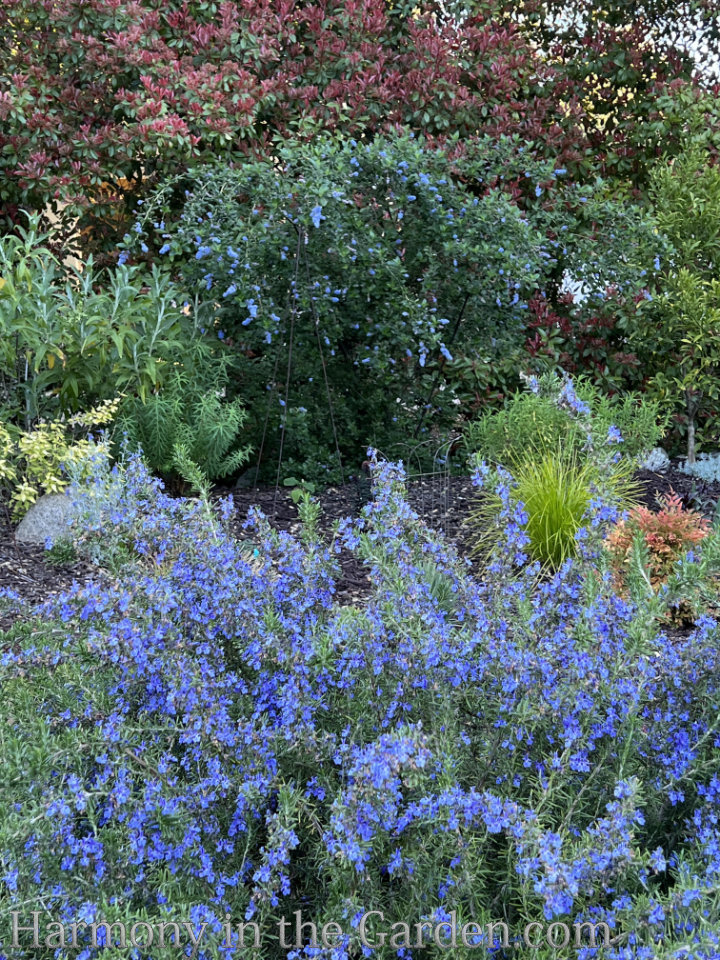
My all-time favorite rosemary variety is ‘Mozart,’ and my advice is to grab a few whenever you see them available in the nursery.
One reason is the color – holy cow! It has one of the darkest and vibrant blue colors I’ve seen and is such a welcome sight in late winter. I took this photo just this morning, March 6th, and it’s been blooming for a few weeks now!
‘Mozart’s’ dimensions are what also make it a treasure in the garden, growing to a mid-sized 2 ½ x 4’.
I find this size is perfect for gently spreading to fill a space while still providing a bit of ‘bulk’.
I use it near the front of the border, as you can see in this part of my garden, where it butts up against my driveway.
The color!


‘Chef’s Choice’ (a Sunset introduction) is another variety with even tidier dimensions, growing to about 18” x18”.
In my last garden, I had it tucked at the front of my small vegetable bed, as you can see in this photo.
I only wish it had been blooming at the time, but alas it wasn’t.
This variety has an exceptionally high oil content in its foliage, making it a fantastic choice to use in cooking.
If you can’t find ‘Chef’s Choice’, ‘Boule’ is another variety that grows to 2’x2’.

The ubiquitous ‘Prostratus’ (or Creeping Rosemary) is even lower growing, just 1’x 5’ wide, making it ideal for draping over walls.
One of my long-time clients has several varieties of rosemary in her garden, including the creeping rosemary that gently grows over her garden’s walls.

Even though r. prostratus is one of the most common varieties of all, that doesn’t mean it isn’t stunning in the right scenarios. In the example, below, I’ve used the blue flowers of the Creeping Rosemary to create the illusion of a waterfall near my client’s pool.

Middle of the border
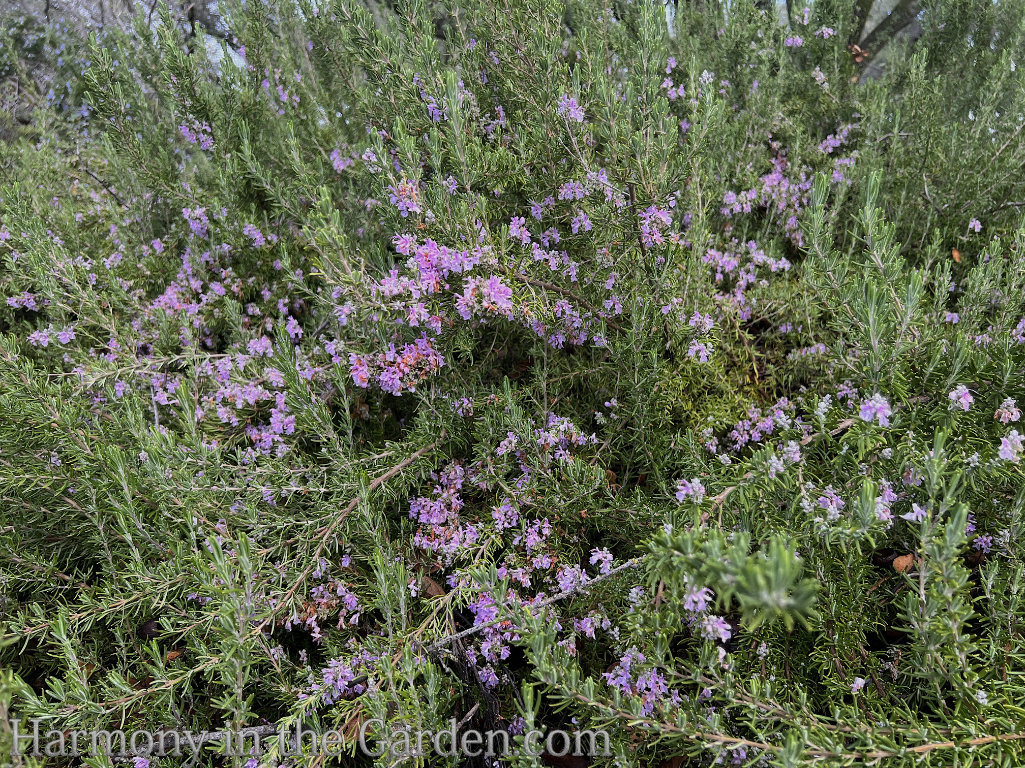
Taller varieties that grow with an upright form, like ‘Ken Taylor’ (4’x3’ wide), are ideal for the middle layer of a garden.
‘Majorca Pink’ (left) is another upright variety with pink flowers (a nice alternative to all the shades of blue out there,) which grows to 3-4’ x 3’wide.
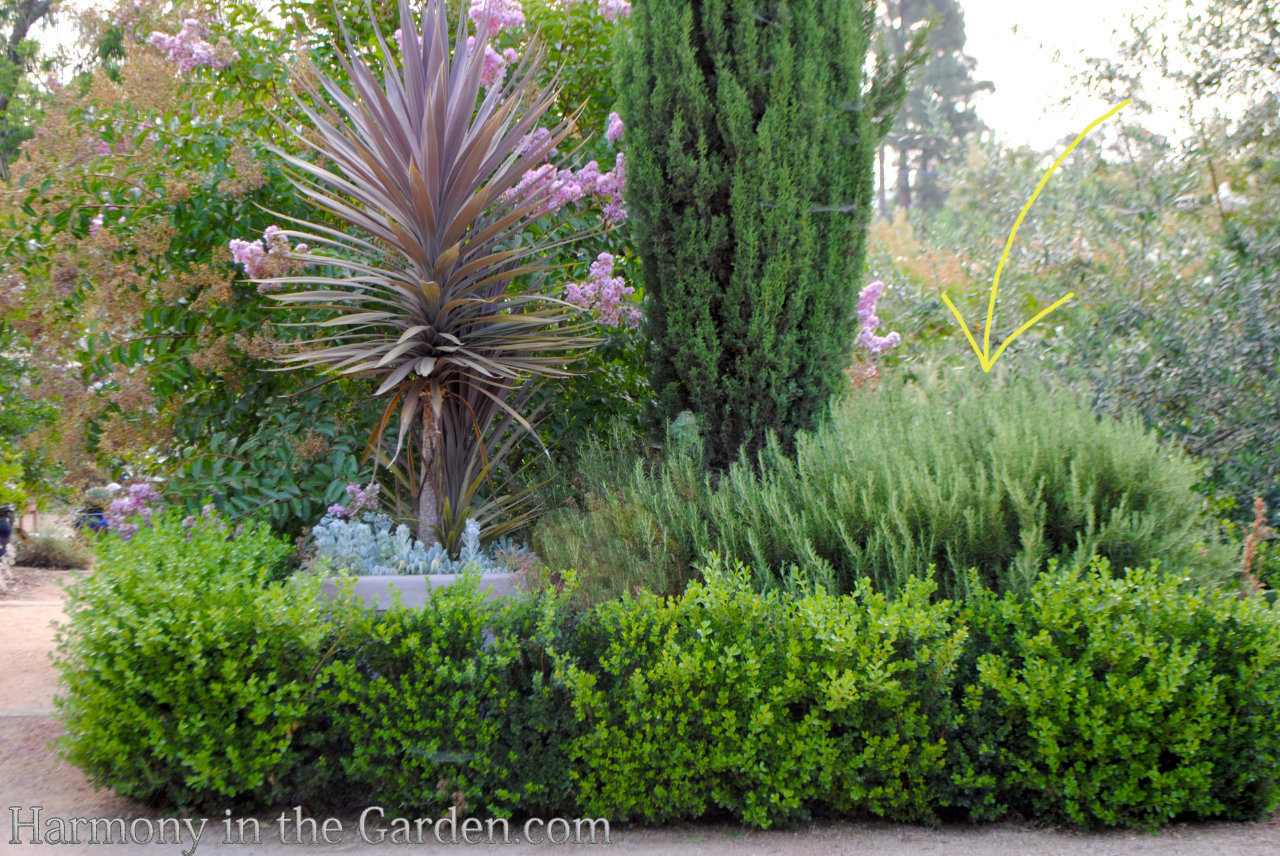
In Pasadena’s Arlington Garden, an upright form of rosemary is pruned to create a perfect middle layer placed behind the boxwood border.
I just love this low-water combination of boxwood, rosemary, and the maroon cordyline in the container.

Click here to read more about my visit to this hidden gem of a garden.

Years ago, while visiting Sunset Magazine’s former headquarters in Menlo Park, I couldn’t stop photographing the inner courtyard’s rosemary hedge in full bloom.
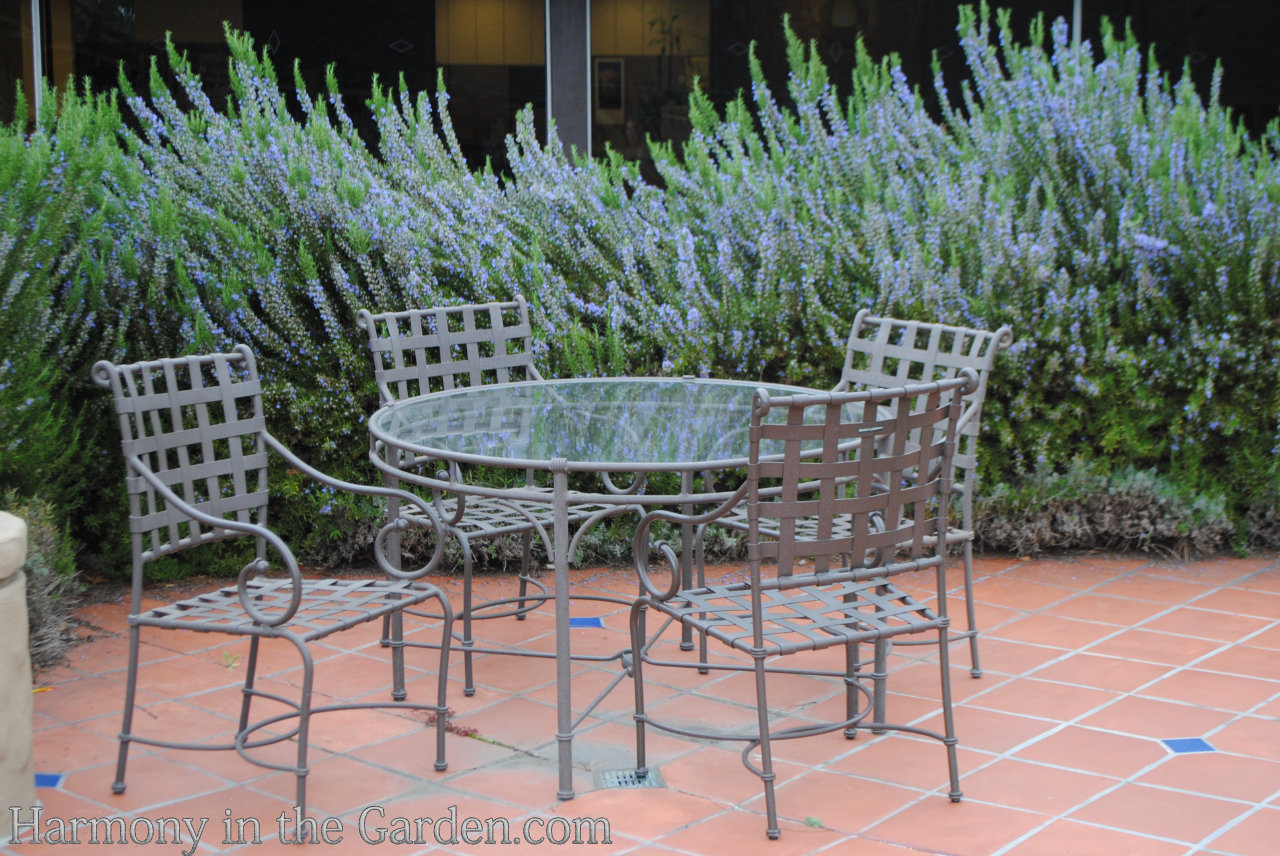
Kept at a manageable 5-foot height, it’s the perfect low maintenance, drought-tolerant, and evergreen backdrop for a seating area.
Back of the border
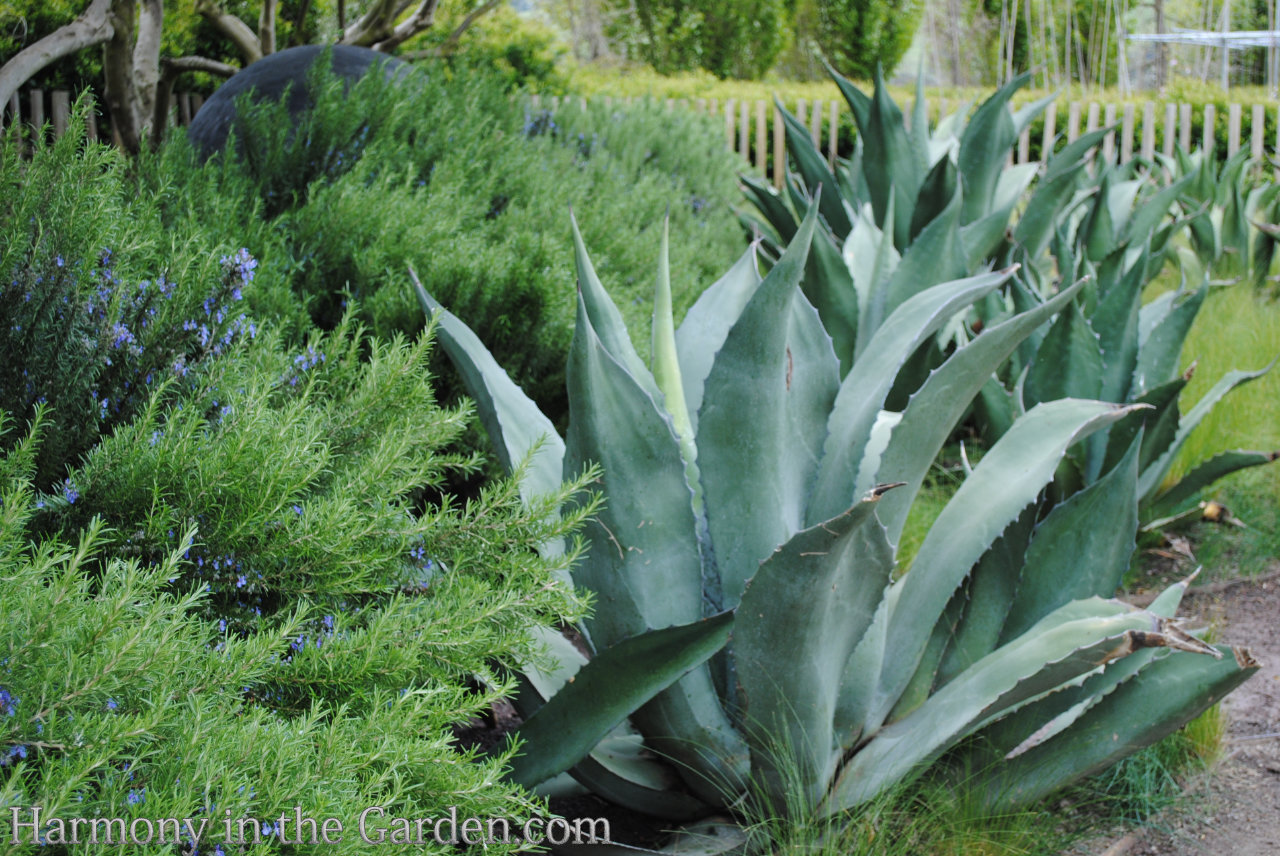
When left unpruned, ‘Tuscan Blue’ can grow upwards of 6’ tall, making it a stunning backdrop that fills a space with its soothing green foliage.
At Cornerstone’s ‘Garden of Contrast,’ created by James van Sweden and Sheila Brady, a swath of rosemary (which, I think is ‘Tuscan Blue’) gently embraces the agave americanas.

Behind the agaves, is a sculptural sphere, created by artist Grace Knowlton.
The rosemary has been allowed to grow around and gently cradle the sphere.

Along a similar vein, I’ve used ‘Tuscan Blue’ to grow around and gently cradle my client’s decorative olive jar.
Combining Layers

In my client’s garden, we’ve combined the low-growing ‘Prostratus’ and the taller ‘Tuscan Blue’ for a dynamic, bullet-proof combination.
As an added bonus, the shades of blue are different on each of the two varieties, providing long-lasting, colorful contrast.
Containers

Rosemary plants do surprisingly well in containers, just as long as they’re fast draining. All varieties of rosemary hate ‘wet feet,’ so it’s crucial the soil quickly drains.
For at least 15 years, I’ve had this rosemary growing in this pot.
I originally found it on the sale table at Rogers Reynolds nursery (anyone remember that Menlo Park gem?)
It was only an 18”-tall topiary that had a severe lean to it and was a little sickly looking, so for $10 I took it home to see if I could revive it.
15-years later, it’s over 5’ tall and never fails to be the first to bloom with pale blue flowers, often starting in late January.
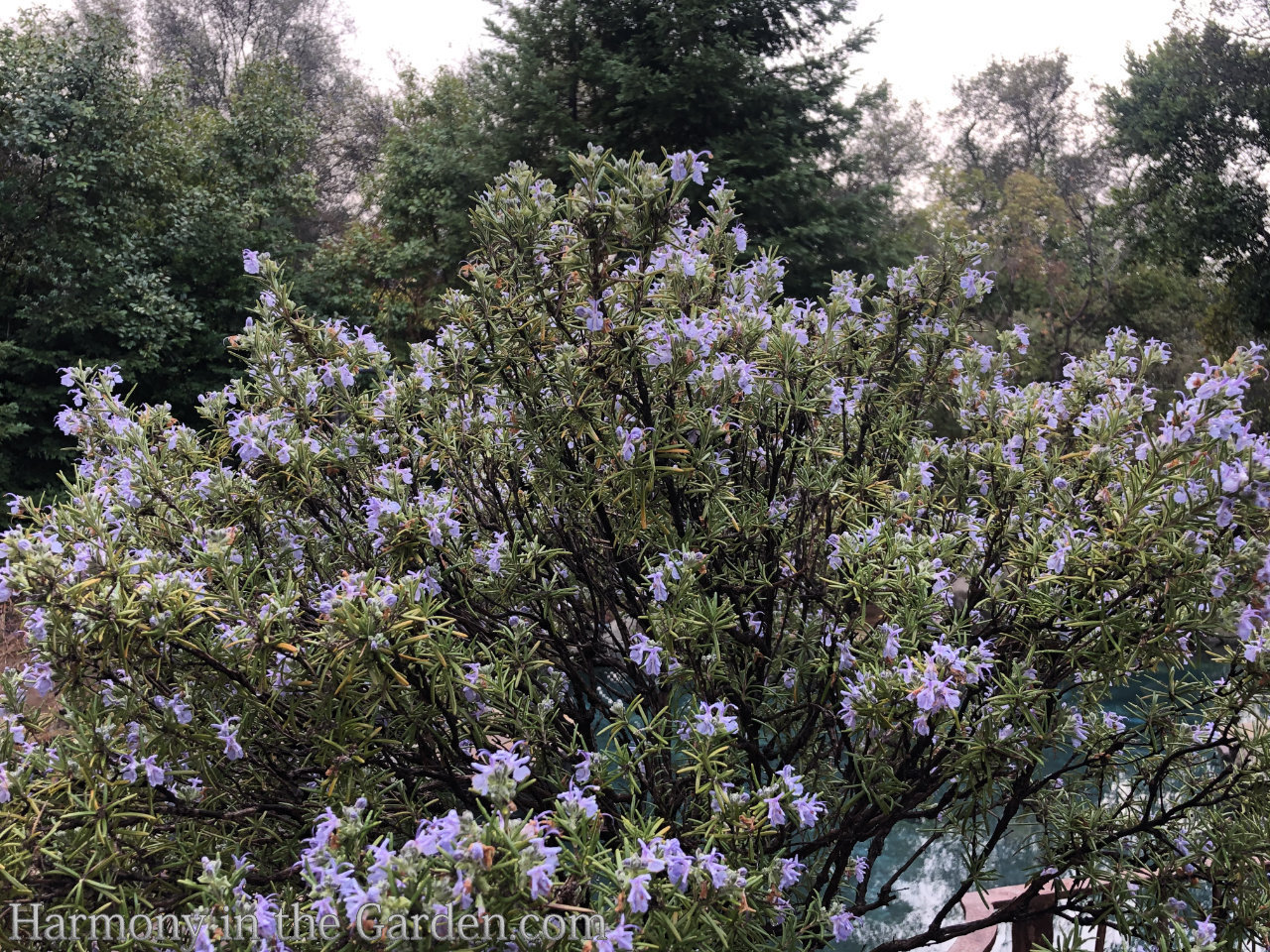
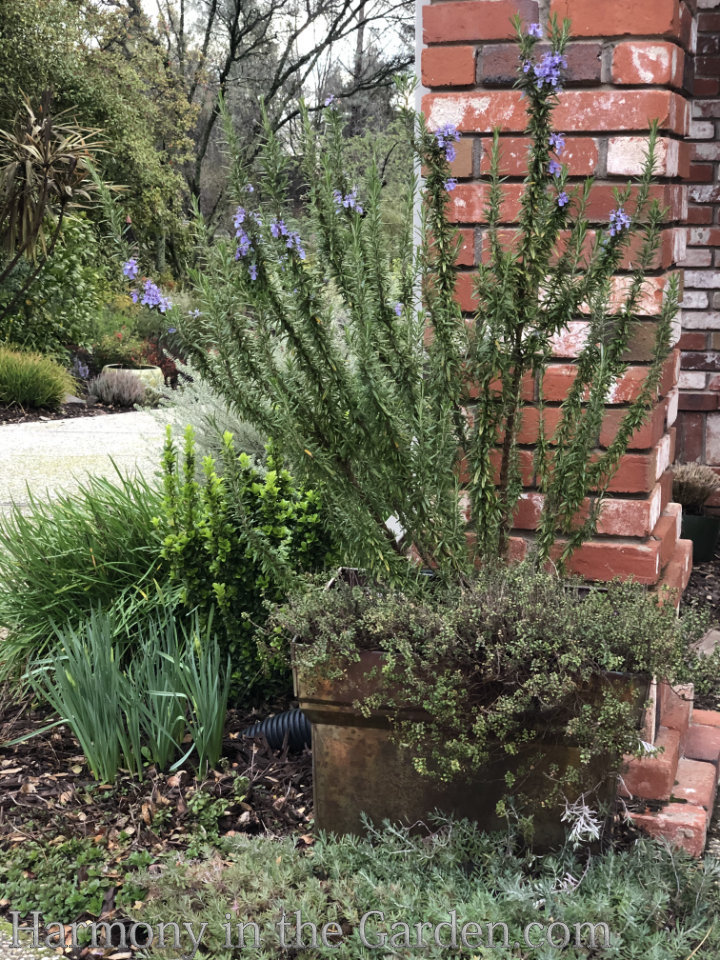
This is another container that I’ve placed at the very end of my awkward ‘carport’ garden.
I’ve had the beautiful copper container for years (from H. Potter), and it’s been home to a ‘Tuscan Blue’ rosemary.
This particular area of my garden gets unrelenting summer sun, which means whatever I planted in there would have to be bullet-proof as the container dries out quickly.
Rosemary was a perfect choice.
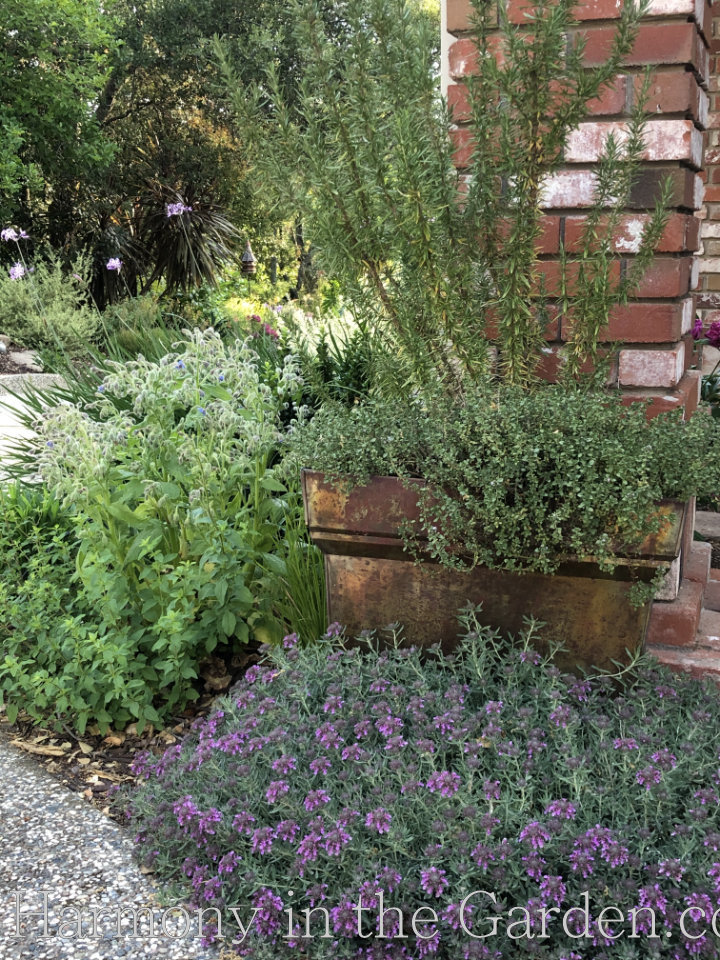
At the foot of the container is a teucrium cossonii, which also requires very little water and is happy with the little bit that drains from the bottom of the container.
The teucrium begins blooming just as the rosemary finishes, providing an additional three months of flowers.

I think the #1 reason I love rosemary plants so much is for their abundance of early spring flowers, signaling the end of winter.
Dark blue, light blue, pink, and even white – seeing masses of tiny, fragrant flowers on a late winter day is a sight to behold.
Banning rosemary from the garden just because it’s common? No way!
With so many varieties on the market these days, I’m sure I’m missing out on a few, so please share any of your favorites with us!
P.S. I’ve had some readers ask about cold-hardy varieties and it seems there’s a few selections that are hardy down to Zone 5 – hooray! Click here to read the article.
The important thing to remember is to make sure they have fast draining soil as they HATE to sit with wet and soggy roots. Mix in plenty of small gravel, or better yet pumice (here’s an article about pumice, if interested.)






22 Comments
Well, I’m a late reader again. Loved this article and now I’m going to take some cuttings off rosemary growing in the planter in front of the house so I can fill in some space in my upper yard garden. I have three in the planter and they are loving it – growing towards the stone facing on the lower part of the house, probably because of reflected heat. At least that’s my guess. I don’t know the variety but it will make a lovely backdrop/filler for some currently weed filled spaces in the garden.
Great idea, Barbara – yes, I’m sure yours are so happy with the reflected heat (the hotter, the better for them!) and I bet they’ll look beautiful in their new spot. Good luck taking cuttings – it’s a good time of year to do it!
I really identified with this article. Rosemary is my favorite! I was introduced to this plant as a young boy on the Croatian islands and have been growing it ever since now that I live in the NY Hudson Valley where they happily grow wrapped for frigid winters of course. Your article gave some wonderful advice on usage and placement and I look forward to planting my newly rooted plants in more challenging settings that I’ve overlooked. Thanks for the inspiration!
Hi Walter – I’m so glad you enjoyed my article. I’m so happy to hear that you’re able to have it survive your cold, cold winters – you must do a fantastic job protecting it! I’ve been to the Hudson Valley area a few times and boy, is it beautiful. Lucky you to live in such a glorious place!
I love the Rosemary in our garden. I will try to identify it now with all the wonderful examples you have shown. We have been using it to cook and are delighted to be growing some of our own spices. What fun! I always love your article and look forward to learning something every time. I hadn’t thought of the skewer idea. Brilliant!
Thanks, Carol, and I hope you enjoy your rosemary-infused shish kebabs! 🙂
Great post to read this morning while enjoying the rosemary outside my window. I have quite a few rosemary plants and I love how tough they are and drought tolerant. The scent is wonderful especially when the temperature gets over 100 degrees here in the Sacramento Valley. Think I’ll plant another.
Thanks, Donna, I’m glad you enjoyed my post. And I’m with you! Anything that can tough it out during our insanely hot summers is a star in my book!
Great article about a touch plant! And this time of year, our honeybees are enjoying the flowers!! So enjoyed “seeing” you at the Garden Club of Los Altos on-line meeting – your presentation was great!
Hi Kris, and I’m so glad you enjoyed my talk. It was fun to be back again (even virtually – heck, I’ll take it!)
Wow. Ok so now I have to find myself some ‘Chef’s Choice’ or ‘Boule.’ Great Post!
Thanks, Katie – I’ve been able to find ‘Chef’s Choice’ at our local nursery with little problem so I hope you can, too!
Thanks for another great informative article, who knew there were so many varieties of rosemary! Also, what a great surprise to read about the Arlington Garden in Pasadena, I went for the first time last year, what a pleasant surprise it was.
Wow Vivian, that’s fantastic that you were able to visit the garden – I hope it still looked amazing after all these years! It was such an amazing discovery for me at the time, stumbling upon a hidden treasure like that. Ahhh…those were the days. 🙂
Thank you for the book recommend! My daughter has recently begun to seriously garden so I ordered Michele’s book for her! Nothing warms a mother’s heart like a daughter who loves to garden!
I’m so happy for you, Donna – and I know how you feel! My daughter has finally started showing a real interest in gardening. Even though she lives in an apartment, she loves houseplants and every time she visits me she asks to go to the nursery with me. I just about faint every time that happens – music to my ears!
What variety is the hardest? Live in zone 5 but may be able to find a few zone 6 niches….
Hi Virginia, it seems ‘Arp’ and ‘Hardy Hill’ are two that are hardy all the way down to Zone 5. They just don’t like to have their roots sitting in water, so it’s super important to make sure they have fast drainage (maybe placing a fair amount of small gravel at the bottom of the large hole that you dig so water doesn’t pool, or mix in pumice.) Here’s a good article: http://theherbexchange.com/whos-the-hardiest-of-them-all/
will rosemary do well in coastal SW Florida
Hi Rebecca, I was googling your question and it seems like it will (https://www.flgardening.com/growing-rosemary-in-florida/) and then I found another interesting article about a ‘beach rosemary’ that grows in your area. Though not a true rosemary, it looks like one. Here’s the link: https://davesgarden.com/guides/articles/view/2808#:~:text=It%20is%20often%20found%20along,clothe%20the%20plant%20year%2Dround.
So many beautiful instances of rosemary. I may take a look at it for several spaces in my garden.
I’m glad you enjoyed the article, Judy – there’s a size for just about any space. I hope you can find the ‘Mozart’ as the photos don’t do its amazing color justice.